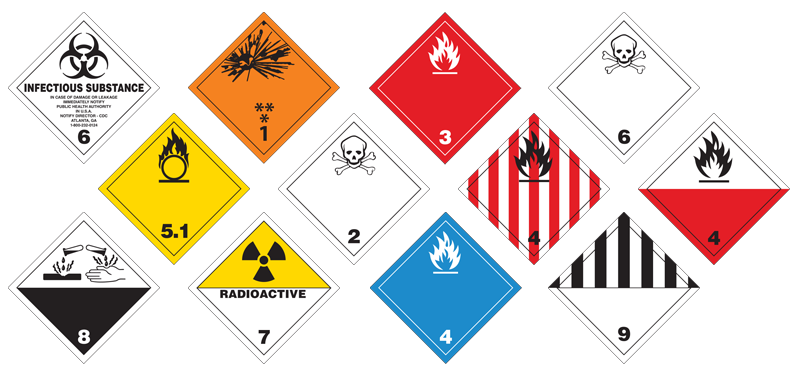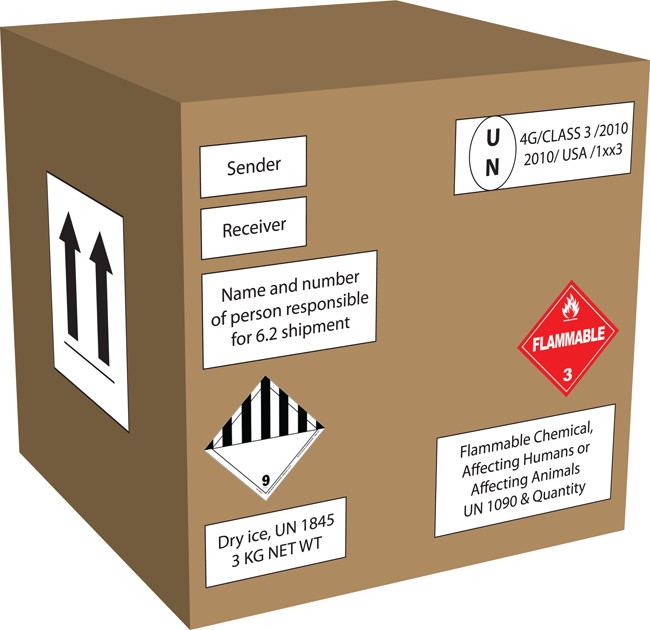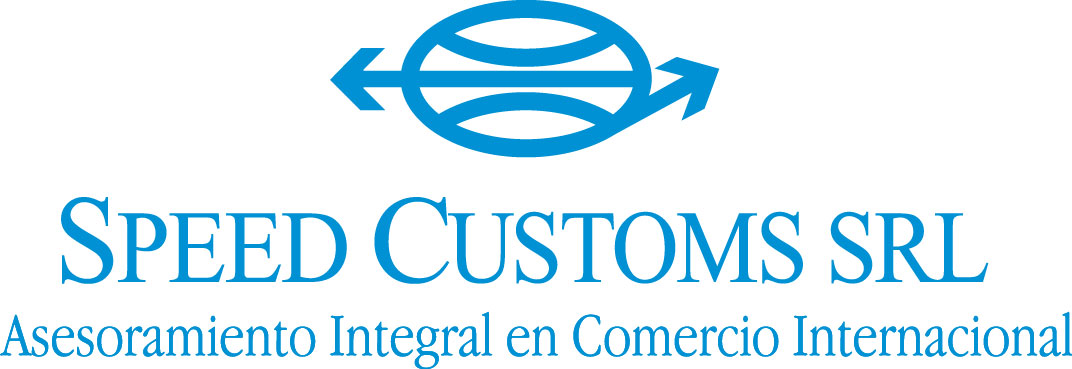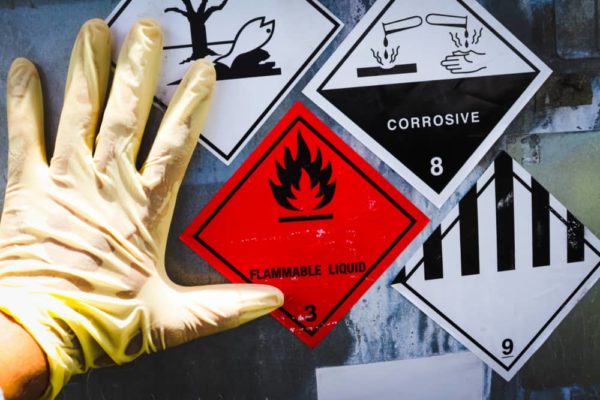Dangerous goods
The dangerous goods they are subjects or objects that they pose a risk to the health, safety, or which can cause damage to the environment, in properties, or to the people. The term dangerous goods it is used in the field of transport; in the areas of health safety or labeling, uses the term " dangerous substance or preparation.
Class 1: Materials and explosive objects
Within this class, subjects, and objects are subdivided based on the risk of mass explosion, projection or fire.
Examples: Fireworks, flares, bombs, rockets, ammunition, fuses, detonators, and other.
The explosive materials are classified into:
- Division 1.1 : substances and articles which present a risk of explosion of the entire mass.
- Division 1.2 : Objects that represent a projection hazard but not a risk of explosion of the entire mass.
- Division 1.3 : substances and articles which present a risk of fire and a risk to produce small effects of shock wave.
- Division 1.4 : Objects no represent a significant risk.
- Division 1.5 : Matters very little sensitive that involves a risk of mass explosion.
- Division 1.6 : Objects extremely little sensitive, that do not pose a risk of explosion of the entire mass.
Class 2: Gases
They are subjects that at normal pressure and 20 ° C are in a gaseous state, or with a vapor pressure higher than 3 bars at 50 ° C. The gases can be liquefied, compressed or cooled.
On the basis of their properties can be classified as an asphyxiant, oxidizing, flammable, or toxic. Under this classification there are three divisions.
- 2.1 flammable Gases
Gases which at 20 °C and a pressure of 101.3 kPa:
- Are flammable mixture ratio of less than or equal to 13% in volume.
- It has a range of flammability with the air of at least 12%.
This is, in short, gases which may ignite in contact with a heat source. Eg. propylene, ethane, butane.
2.2 Gases non-flammable, non-toxic
They are gases that:
- Diluted , supersede or displace the oxygen in the air, causing suffocation.
- They have the characteristics oxidising. and favor the combustion to a greater extent than the air. Eg. oxygen, helium.
- Cannot be ascribed to any of the other classes.
2.3 toxic Gases
They can produce, by inhalation, acute or chronic, or irritants, and even death. The toxic gases may be flammable, corrosive or oxidising. Eg. chlorine. It is considered toxic when present with a LC50 of 5000 parts per million.

Class 3: flammable Liquids
Are liquid whose flash point is 60 ° C. These materials can be present, in addition, features that are toxic or corrosive. Eg. toluene, thinner, gasoline, paints, varnishes.
Class 3 consists of the following substances:
- Flammable liquids.
- Liquid explosives-insensitive.
Flash point a flammable liquid: it Is the lowest temperature of the liquid at which its vapours form with air a mixture flammable.
Not to be confused with flash point that is the temperature that is to elevate the-air mixture vapors to actually cause an explosion.
Class 4. Flammable solids, substances that can undergo combustion spontaneous, substances which in contact with water emit flammable gases
Class 4.1: flammable solids, subjects self-reactive and explosive materials desensibilizadas solid
Are those that can react spontaneously. Are solids under normal conditions of transport are flammable and may favor fire by friction. • Risk of fire. • Flammable materials or combustible, may be ignited by heat, sparks or flames. • May contain material self-reactive with the possibility of decomposition exothermic under the effects of heat, contact with other materials (such as acids, compounds of heavy metals or amines), friction or shock. • This may result in the emanation of gases or vapors are harmful and flammable.
Class 4.2: Materials may ignite spontaneously
(division 4.2 are including the materials called pyrophoric ) Substances that can warm up spontaneously in normal conditions of transport or can be heated by coming into contact with the air and can be ignited. For example: Coal, wood chips, from ferrous metals, cotton cloth, etc
Class 4.3: Materials in contact with water emit flammable gases
Covers various types of materials that come into contact with water, emit flammable gases.
The panels of danger usually wear an X preceding the identification of such a danger.
For example: Barium, Sodium, Potassium, Carbide Calcium, etc...
Class 5.1: oxidising substances
Are liquids or solids that can cause or promote combustion (generally give rise to reactions that release oxygen)therefore in contact with other materials to increase the risk of fires, and favor the development of the same. Eg. ammonium nitrate.
Mixtures of oxidizing substances with combustible materials, and even with materials such as sugar, flour, edible oils, mineral oils, they are dangerous.
In contact with acidic liquids, the majority of the oxidizing substances produce a violent reaction with evolution of toxic gases.
Class 5.2: organic Peroxides
Organic peroxides are substances which are susceptible to undergo decomposition exothermic temperatures, normal or elevated. Decomposition may occur by heat, contact with impurities, by friction or impact. Are materials derived from hydrogen peroxide, where one or two of the hydrogen atoms are replaced by organic radicals.
Organic peroxides are divided into:
- Not more than 1% of active oxygen from the organic peroxides when its content of hydrogen peroxide is not more than 1 %.
- Not more than 0.5 % of active oxygen from the organic peroxides when its content of hydrogen peroxide is more than 1% but not more than 7%.
There are quantity limitations for loading on a transport unit, for being a material very dangerous.
Class 6.1: toxic substances
Materials that, in relatively small amounts, may cause damage to the health of human beings, or to cause his death, by inhalation, skin absorption, or ingestion. Eg. methanol, methylene chloride.
By its very nature, this substance involving the risk of poisoning if they come in contact with the human body.
Almost all of the toxic substances give off toxic fumes if a fire does or if heated to decomposition.
Class 6.2: infectious Stuffs
- Subjects who are known or believed to contain pathogens, i.e., micro-organisms (bacteria, viruses, prions) that can cause diseases to animals or to human beings. Eg. diagnostic samples or trial.
- Biological products, products derived from living organisms that require special treatment for your transport, Eg. material intended for the production of vaccines for human beings or animals.
- Crops, laboratory for the study of human or animal disease.
- Specimens of patients Materials: human or animal extracted from patients. Ex secretions, faeces, blood or cellular tissue.
- Genetically modified micro-organisms: any organism that has been modified using genetic engineering that does not occur naturally.
- Medical or clinical wastes: disposable material of the clinical practice in humans or animals or biological research.

Class 7: radioactive Matter
- Uranium-233.
- Uranium-235.
- Plutonium-239.
- Plutonium-241.
- Any combination of these radionuclides.
Materials alpha emitters of low toxicity are:
- Natural uranium.
- Depleted uranium.
- Thorium natural.
- Uranium-235.
- Uranium-238.
- Thorium-232.
- Thorium-228.
- Thorium-230.
All of them contained in ores or concentrates physical or chemical or alpha emitters with a half-life of less than about 10 days.
Class 8: corrosive substances
The subjects or objects which, by contact, damage the epithelial tissue of the skin, mucous membranes, or eyes; or that may lead to damage to other goods or property in the event of a spill. Eg. sulfuric acid, sodium hypochlorite.
All the substances of this class with destructive effects to a greater or lesser degree on materials metals or textiles.
In addition to acting directly in a destructive manner if they come in contact with the skin or mucous membranes, some of the substance of this class are toxic or harmful. Ingestion or inhalation of its vapors can result in poisoning and some of them can even cross the skin.
Class 9: the Materials and objects that pose dangers to various
They are subjects that pose some kind of danger, not referred to above: dioxins, fine powders, which can cause damage to the respiratory tract, lithium batteries, hazardous materials to the environment, and within this category the most common commodity is dry Ice (CO2) which is used to cool various products.
The substances that are transported or to be presented for transport at temperatures equal to 100 °C.
The genetically modified organisms that do not respond to the definition of infectious substances but that may result in animals, plants or microbiological substances modifications that normally would not occur as a result of natural reproduction.

